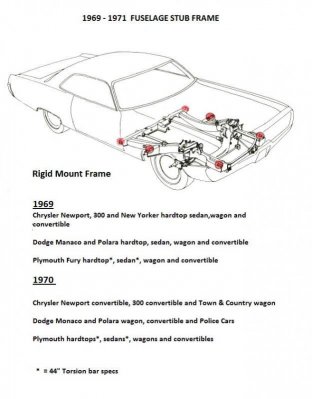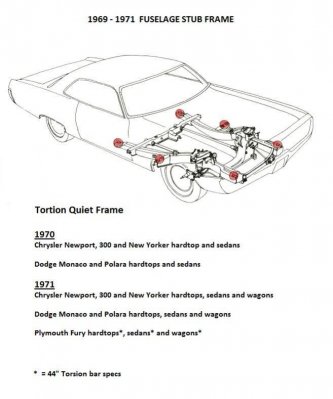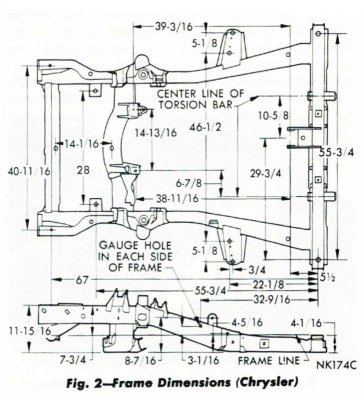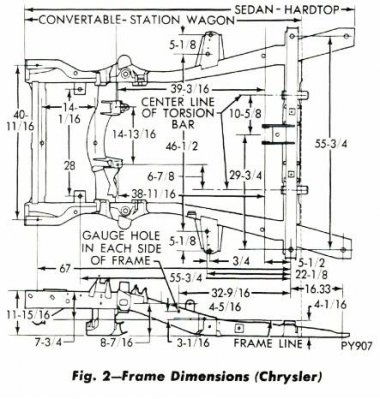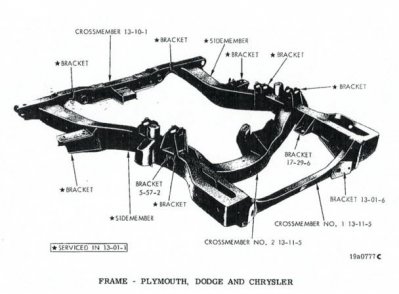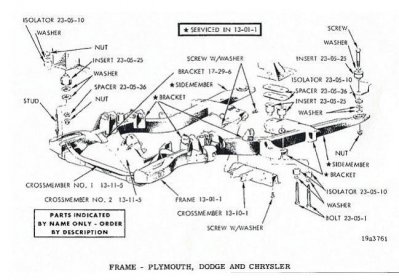There seems to be alot of mystery and mis information regarding the front forestructure (stub frame) on the 1969-1971 Chrysler C bodies as to which will fit which and what will bolt up to what. It’s pretty simple really, there are the rigidly mounted stub frames that bolt directly to the body and there the “Torsion Quiet” stub frames that have rubber isolators between the body and the stub frame.
1969
In 1969 all Chrysler and Dodge hardtops, sedans, convertibles and wagons used the same stub frame, with only the Plymouth hardtops and sedans using a different stub frame. The Fury frame will bolt up to any of the other cars in the line up and will have most of the same dimensions but is built to accommodate the hardtop and sedan shorter torsion bars (6cyl and V-8 applications differ).1970
In 1970 Chrysler came out with what they called “Torsion Quiet Ride”. This system changed how the stub frame was mounted on the Chrysler and Dodge hardtops and sedans. The Torsion Quiet stub frame was similar but different, the outriggers were redesigned to allow for the rubber bushings to fit in between the frame and body. The stub frame was also lengthened about 16 1/2 inches behind the transmission crossmember where another rubber isolated mounting point was added. These stub frames will not bolt up rigidly to the body. The same rigid mount stub frame from 1969 was retained for the Chrysler, Dodge and Plymouth convertibles and wagons as well as a Dodge sedan when ordered as a Police Car. Plymouth hardtops and sedans still used the same stub frame from 1969 to accommodate the Fury’s shorter torsion bars (6cyl and V-8 applications differ).1971
In 1971 all Chrysler full size C bodies used the Torsion Quiet Ride system including station wagons. Convertibles were dropped from the line in 1971.TO SUM IT UP
All 1969 C Bodies, with the exception of Fury hardtops and coupes are interchangeable.
1969 - 1970 C body Convertibles or Wagons can use the stub frame from any 1969 Chrysler, Dodge or Plymouth convertibles and wagons. 1970 - 1971 Chrysler and Dodge and 1971 Plymouth's will not bolt rigidly to the frame and will not work on all 1969 models or 1970 convertibles and wagons or Plymouth hardtops and sedans.
1969 - 1970 Fury hardtop and sedans are interchangeable (6 cyl and V-8 applications differ)
Rigid mounted stub frame cars use different wheel houses and radiator core supports than Torsion Quiet cars.
All 69-71 Imperials have a rigid mount stub frame that will bolt up to the other Chrysler, Dodge and Plymouth cars but are totally different. In theory you could build yourself an Imperial convertible or station wagon with all the right parts
1969 - 1970 C body Convertibles or Wagons can use the stub frame from any 1969 Chrysler, Dodge or Plymouth convertibles and wagons. 1970 - 1971 Chrysler and Dodge and 1971 Plymouth's will not bolt rigidly to the frame and will not work on all 1969 models or 1970 convertibles and wagons or Plymouth hardtops and sedans.
1969 - 1970 Fury hardtop and sedans are interchangeable (6 cyl and V-8 applications differ)
Rigid mounted stub frame cars use different wheel houses and radiator core supports than Torsion Quiet cars.
All 69-71 Imperials have a rigid mount stub frame that will bolt up to the other Chrysler, Dodge and Plymouth cars but are totally different. In theory you could build yourself an Imperial convertible or station wagon with all the right parts

